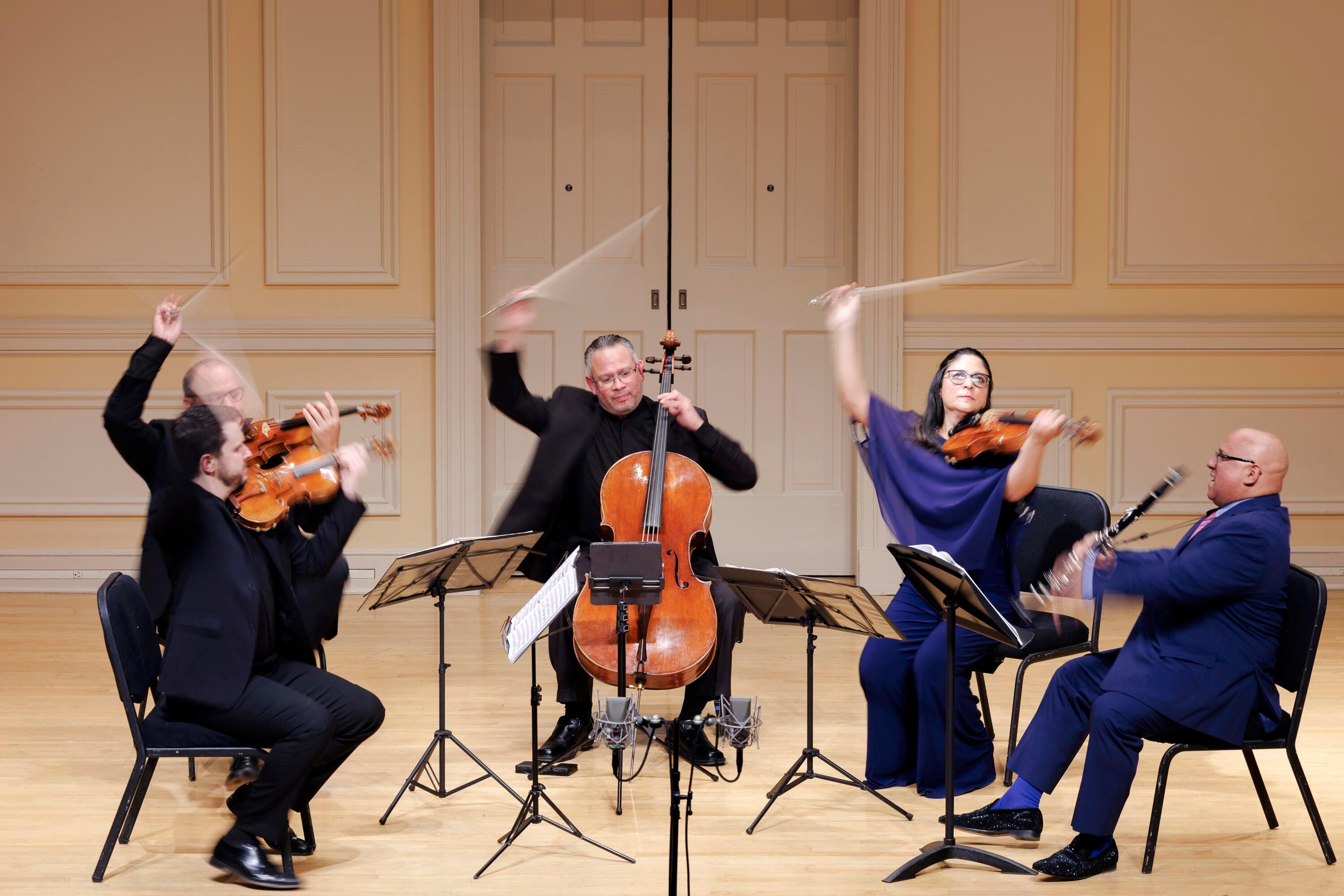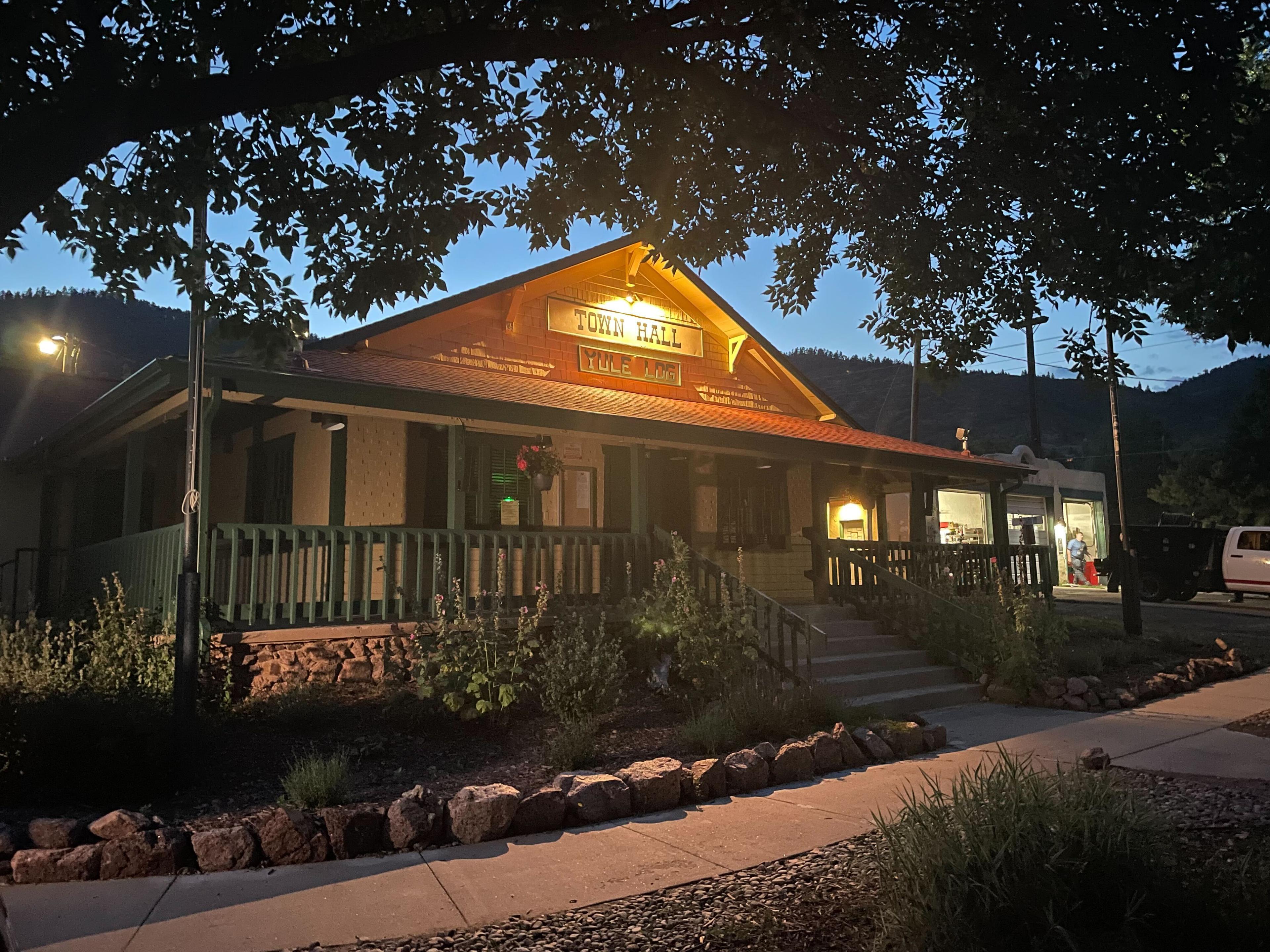
The year is 1925. The Great Gatsby is published, the jazz age is swinging, and on October 28th, a new concert hall opens at an unlikely spot — the Library of Congress, in Washington D.C. If only its cream-colored walls could talk. For 100 years, performers of all stripes have graced the Library stage, from classical music luminaries like Béla Bartók and Igor Stravinsky to Stevie Wonder, Audra McDonald and Max Roach. Today, it remains one of the capitol city's most beautiful, best sounding and perhaps best kept secrets.
The idea for a concert hall at the Library of Congress did not stem from congress. It came from philanthropist Elizabeth Sprague Coolidge — and one bespoke piece of bipartisan legislation. "She was indefatigable and intrepid," says Anne McLean, senior producer for concerts at the Library, "a remarkable woman, six feet tall, a brilliant pianist." McLean is sitting with me on the stage, overlooking the empty auditorium. To mark the centennial, celebratory concerts and commissions have been heard in the hall all year. But not now. The government shutdown has forced the hall to close its doors, and unless a deal is reached before Tuesday, it'll be closed on the anniversary itself.
Coolidge was born into a wealthy Chicago family in 1864. She studied music, traveled abroad, married a Harvard-trained orthopedic surgeon and, in 1924, came to Washington to establish a foothold in the nation's capitol. She approached Carl Engel, the Library's music chief, about the possibility of adding a small concert hall to the Library's voluptuous — and voluminous — Thomas Jefferson building, designed after the Paris opera house and completed in 1897. You can't see the hall from the outside, as it's tucked inside the building's Northwest Courtyard.

Eager to get started, Coolidge wrote a check for $60,000 to the Librarian of Congress, Herbert Putnam, on Nov. 12, 1924. And yet there was no legal mechanism in place for a civilian to make such a monetary gift to the U.S. government. Congress worked quickly, taking only a little over a month to pass a bill allowing such a contribution.
It took less than six months to build the hall itself — the intimate, 485-seat Coolidge Auditorium, with its warm precise acoustics. "There are a lot of secrets to it," McLean says. "The back wall of the auditorium is slightly shaved to be concave and extremely responsive to string sound. Underneath the stage is hollow. But that hollowness is a factor, as is the cork floor, which was very unusual for its time." McLean says the sound blossoms in the hall. Keen to spread the sound far and wide, Coolidge even had the building wired for the relatively new medium of radio. She added to her initial sum to establish a fund for the commissioning of new music. Engel dubbed her "The Fairy-God-Mother of Music."

Coolidge was well-connected and fiercely advocated for music. In 1944, she took to the local Washington airwaves with another bold idea. "I could wish for music, the same governmental protection that is given to hygiene, education or public welfare," she said over WTOP. "How wonderful, if we could have in the cabinet, a secretary of fine arts."
Coolidge never got her wish, but what she had already created was arguably more important — a living, breathing concert hall that serves as a cultural beacon — preserving history and cultivating new music through commissions.

Perhaps the most famous commission became one of America's most iconic pieces of music. Aaron Copland's ballet Appalachian Spring, written for dancer and choreographer Martha Graham, received its world premiere at Coolidge Auditorium on Oct. 30, 1944. "I think people knew what they were hearing," McLean says. The ballet would win the Pulitzer prize for music the following year, along with the New York Music Critics Circle Award. It's hard to imagine a full ballet produced on Coolidge's modestly-sized stage.
"Now that you're sitting on it, you can see how very small it is," McLean observes. "There's very little fly space for anyone to make an entrance, much less dancing and major choreography. And where you see the front row of our seats, that was the orchestra pit. It only could fit 13 people."
And the commissions keep coming, thanks in part to generous women who followed in Coolidge's philanthropic footsteps. Composers commissioned for the 100th anniversary include MacArthur fellows Tyshawn Sorey and Vijay Iyer, plus Pulitzer winner Raven Chacon, George Benjamin and the electronic artist Jlin. Pulitzer-winning composer Tania León had her own world premiere earlier in this 100th anniversary season. Para Violin y Piano was commissioned by the Library's Leonora Jackson McKim Fund, an endowment focused on pieces written for violin and piano.

"My experience in the hall is, in a way, transcendental," León says. "It's like touching the past into the present. And the honor to be included in the roster of all of the composers is very powerful." That roster of composers who have been commissioned by the Library is impressive — from Stravinsky's ballet Apollon Musagète (1928) and Bartók's String Quartet No. 5 (1935), to Jennifer Higdon's Viola Concerto (2015), which won a Grammy.
Situated inside the Library of Congress, Coolidge Auditorium benefits from the Library's substantial acquisitions. In the mid-1930s, another philanthropist, Gertrude Clarke Whittall, gave the Library a set of rare Stradivarius instruments. At the time, such a collection of rare string instruments was unique at a public institution in the U.S. "When they were first acquired, there wasn't a resident ensemble. And the concept was, 'How do we keep them in great shape?' So they were occasionally hiring musicians to play them for $2.50 an hour," McLean says with a laugh.
Beginning in 1940, the Library didn't have to worry about hiring musicians off the street. The renowned Budapest String Quartet, fleeing World War II, became the first such ensemble to take up residency at Coolidge Auditorium. The group stayed for 22 years. The Juilliard Quartet picked up the mantle in 1962, routinely playing the precious instruments in 560 concerts over a four-decade span.

These days, the Strads can be played by any string quartet booked for a concert at the Library. But McLean says there's a catch: The musicians need to show up a couple days early to learn how to control them. "The secret of the instruments is that they are like racehorses, they're thoroughbreds, and they can get away from you if you don't have a chance to get used to them."
Cellist Daniel McDonough and his bandmates in the Jupiter String Quartet got used to them when they played the Strads at the Library earlier this year. I asked McDonough if playing one of the instruments was anything like finding yourself behind the wheel of a Ferrari.
"Yes, the automotive analogy is a good one," he says. "Sometimes I say it has a fifth gear. These instruments, because they've been played for hundreds of years and because they've aged and grown into themselves so beautifully, have a kind of ringing tone that I think no other instrument [has]." McDonough played the "Castelbarco" cello, built by Stradivarius in 1697.

"One of the things that's unique about that instrument is it's one of the few remaining Strad cellos that's not cut down," McDonough observes. "It's bigger than instruments in later years, when the cello became more standardized in its pattern and size. So it has a big bass sound." The reason why some cellos were trimmed down in size, McDonough adds, was to make virtuoso playing easier.
Along with the Strads, five in all, the Library houses some 26-million other musical items — 1700 flutes and woodwinds, original manuscripts and memorabilia — some of which are displayed at each concert.

At a Kronos Quartet performance last year, Susan Vita, chief of the music division, who has since died, told the audience before the show that the Library's holdings were about to get a little larger. "We are elated to announce," she said from the Coolidge stage, "that the Kronos Quartet archive will be coming to the Library of Congress." After that announcement, Kronos launched into a concert of American music, capped with its beloved version of "Purple Haze" by Jimi Hendrix.
Kronos founder and violinist David Harrington has long been a fan of the Library. "The Coolidge Auditorium is a mythic, iconic place for music and musicians," he writes in a forward to an upcoming book about the 100th anniversary. He first learned of the hall in 1975 when his teacher gifted him a 1940 concert recording by pianist and composer Béla Bartók and violinist Joseph Szigeti playing Beethoven's "Kreutzer" sonata. The two Hungarians had fled war-torn Europe. "There is an urgency and completeness combined with a beautiful freshness in every note they played on April 13, 1940," Harrington writes. "All the way through the concert it was clear that this performance was a journey, a vital examination of culture and expression unique in recorded history."
While Elizabeth Sprague Coolidge envisioned her hall primarily for classical chamber music, the venue has played host, even early on, to a broad range of styles. In 1926, just over a year after the hall opened, Black composer R. Nathaniel Dett brought in the 80-voiced Hampton Institute Choir to sing spirituals and Christmas carols. Music by W.C Handy was featured in the hall's first jazz concert in 1929, and in 1938, early jazz pioneer Jelly Roll Morton took to the stage, along with folklorist Alan Lomax, to sing and tell some R-rated stories of his life and times. In 2006, a massive set of the Jelly Roll Morton recordings, over nine hours, made on the Coolidge stage, won two Grammys – for best historical album and best liner notes. It's a fascinating oral history of the dawn of the jazz age.

In 1940, the hall celebrated the 75th anniversary of the 13th Amendment with a series of concerts featuring Black artists and music, with soprano Dorothy Maynor, tenor Roland Hayes and guitarist Josh White, who joined the acclaimed vocal group, the Golden Gate Quartet. In 1993, the Library acquired the Charles Mingus collection and marked the occasion with a performance by his big band.
"We're grateful to be able to present incredible musicians from many walks of life, many genres," McLean says. During the height of the pandemic, when the hall was closed, the Library released a series of video presentations, from Cuban vocalist Daymé Arocena and Argentine pianist-composer Pablo Ziegler to the New Orleans-based funk, rock and soul group Tank and the Bangas.
For a century, the walls of Coolidge Auditorium have soaked up the song and the spirit of countless musicians from across the globe — from that very first concert, with its commissioned piece by Charles Martin Loeffler to Bartók's impassioned playing to Stevie Wonder accepting the Library's Gershwin Prize. The hall that Elizabeth Sprague Coolidge built represents a history of American ingenuity, a free and public cultural resource, unmatched in its holdings.
"The place itself is resonant with stories like this," McLean says. "The stage where you are right now has been filled with great music and great musicians for a hundred years, and we hope another hundred."
Copyright © 2025 NPR
Transcript:
SCOTT SIMON, HOST:
The year is 1925. "The Great Gatsby" has just been published. The jazz age is swinging. And on October 28, a new concert hall opens at an unlikely spot, the U.S. Library of Congress in Washington, D.C. For a century, performers of all stripes have graced the Library stage, including Jelly Roll Morton in 1938.
(SOUNDBITE OF ARCHIVED RECORDING)
JELLY ROLL MORTON: Of course, I wrote this tune while I was in Alabama about the year 1905.
SIMON: NPR's Tom Huizenga visited the Library's concert hall recently and says you can feel the spirits of the musicians who played there.
TOM HUIZENGA, BYLINE: I'm on stage here at the Coolidge Auditorium at the Library of Congress in Washington, D.C. The hall is empty, and I'm looking out over the 500 or so seats with Anne McLean, senior producer for concerts here at the Library.
And, Anne, if these beautiful cream-colored walls could only talk. Over the past 100 years, there have been many world-renowned artists who have made music right on this stage.
ANNE MCLEAN: It's a stunning list, beginning with people like Alfred Cortot, Josef Szigeti, Wanda Landowska. Igor Stravinsky performed here, Leontyne Price.
(SOUNDBITE OF SONG, "THE MONK AND HIS CAT")
LEONTYNE PRICE: (Singing) Your shining eye watches the wall. My feeble eye is fixed on a book.
HUIZENGA: That's 26-year-old Leontyne Price in 1953 at the Library of Congress, singing the world premiere of music by Samuel Barber, who was at the piano. The idea for a concert hall at the Library of Congress did not come from Congress. It came from a single determined woman.
MCLEAN: Elizabeth Sprague Coolidge, who built the hall - and it bears her name - was a formidable woman, 6 feet tall. And her mission and mandate for the Library was to ensure that free concerts could be presented here in the hall that she endowed.
HUIZENGA: Coolidge was also a gifted pianist and composer. She fiercely advocated for music. And in 1944, she took to the local D.C. airwaves with another bold idea.
(SOUNDBITE OF ARCHIVED RECORDING)
ELIZABETH SPRAGUE COOLIDGE: I could wish for music the same governmental protection that is given to hygiene, education or public welfare. How wonderful if we could have in the Cabinet, a secretary of fine arts.
HUIZENGA: Coolidge never got her wish, but what she created was arguably more important, a living breathing concert hall that serves as a cultural beacon, preserving history and cultivating new music through commissions. The most famous of those commissions became one of America's most iconic pieces of music.
(SOUNDBITE OF AARON COPLAND'S "APPALACHIAN SPRING")
HUIZENGA: That's Aaron Copland's ballet "Appalachian Spring" in its world premiere at the Library in 1944, one of nearly 700 works the Library has commissioned over the past century. Pulitzer-winning composer Tania Leon had her own world premiere earlier this anniversary season.
TANIA LEON: My experience of the hall is, in a way, transcendental.
(SOUNDBITE OF MUSIC)
LEON: It's like touching the past into the present. And the honor to be included in the roster of all of the composers is very powerful.
(SOUNDBITE OF MUSIC)
HUIZENGA: In 1935, another philanthropist, Gertrude Whittall, gave the Library a set of rare Stradivarius instruments. Anne McLean says string quartets who perform at the Library can play the Strads in concert, but they need to show up a couple days early to learn how to control them.
MCLEAN: The secret of the instruments is that they are like racehorses, and they're thoroughbreds, and they can get away from you if you don't have a chance to get used to them.
HUIZENGA: Cellist Daniel McDonough and his bandmates in the Jupiter String Quartet got used to them. They played the Strads at the Library earlier this year.
I mean, is it suddenly like you're behind the wheel of a Ferrari?
DANIEL MCDONOUGH: Yeah. The automotive analogy is a good one. I mean, I sometimes say it has a fifth gear.
(SOUNDBITE OF JUPITER STRING QUARTET PERFORMANCE OF LUDWIG VAN BEETHOVEN "GROSSE FUGE")
MCDONOUGH: To play on Strads from the golden period, it gives you access to so many different kinds of colors and timbres and resonances that wouldn't normally be possible for us.
(SOUNDBITE OF MUSIC)
HUIZENGA: Along with the Stradivariuses, the Library houses some 26 million other musical items - 1,700 flutes and woodwinds, original manuscripts and memorabilia, some of which are displayed at each concert. At a recent Kronos Quartet performance, the late Susan Vita, chief of the music division, let the audience know that the Library's holdings were about to get a little larger.
(SOUNDBITE OF ARCHIVED RECORDING)
SUSAN VITA: We are elated to announce that the Kronos Quartet archive will be coming to the Library of Congress.
HUIZENGA: After that announcement, Kronos launched into a concert of American music, capped with its beloved version of "Purple Haze" by Jimi Hendrix.
(SOUNDBITE OF KRONOS QUARTET PERFORMANCE OF JIMI HENDRIX'S "PURPLE HAZE")
HUIZENGA: What a broad range of music the walls of Coolidge Auditorium have soaked up, says Anne McLean, from Kronos Quartet, back to Bela Bartok, fresh off the boat in 1940, to Stevie Wonder in 2009, accepting the Library's Gershwin Prize.
MCLEAN: The place itself is resonant with stories like this. The stage where you are right now has been filled with great music and great musicians for a hundred years, and we hope another hundred.
HUIZENGA: Tom Huizenga, NPR News.
(SOUNDBITE OF KRONOS QUARTET PERFORMANCE OF JIMI HENDRIX'S "PURPLE HAZE")









